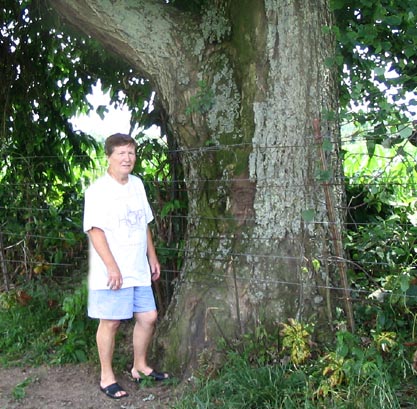| ||||||||||
Dr. Ronald P. Rogers CHIROPRACTOR Support for your body's natural healing capabilities 270-384-5554 Click here for details 


Columbia Gas Dept. GAS LEAK or GAS SMELL Contact Numbers 24 hrs/ 365 days 270-384-2006 or 9-1-1 Call before you dig Visit ColumbiaMagazine's Directory of Churches Addresses, times, phone numbers and more for churches in Adair County Find Great Stuff in ColumbiaMagazine's Classified Ads Antiques, Help Wanted, Autos, Real Estate, Legal Notices, More... 
|
State's largest historic Chestnut tree stands on an Adair County farm The historic Kentucky Chestnut tree recently featured in state and local media is located on the fence line between farms owned by Charles England and Tommy Dowell in Adair County. England received honors from the Kentucky Division of Forestry and the Kentucky Chapter of the American Chestnut Association because he provides a drivable route directly to the tree making for easy pollination activity. Local forest rangers have visited England's farm each spring for the past four years topollinate the tree -- they will be here again next week to attach bags around the pollinatedflowers. Then in the fall they will come back to collect chestnuts from it. What they collect from this Adair County tree will then go to the University of Kentucky for planting. The tree owner's daughter said that of 200 baby Chestnut trees that came from thepollinated Adair County donor tree, none were able to live after being exposed to theAsian chestnut blight that took them all out of this country nearly a hundred years ago. Somewhere in Columbia, or out in the county, lives an original Chestnut tree which was strong enough to resist the killing blight that wiped out nearly every single one of its kind in the early 1900s. Only a select few know where this tree is located and they're not telling. Wherever the original Adair County Chestnut tree is, it is part of history and is also part of our future as researchers study it to see what unique qualities it has which made it strong enough to survive the blight. Even if someone should locate the tree for us, we're not telling either, so that it can continue to stand. The Chestnut tree blight took away nearly a fourth of all Kentucky trees that were used for shelter, furniture and many buildings built from them which still stand. Both people and animals enjoyed the nuts as a part of their regular diets. The Courier article said, "the trees were killed by a foreign disease accidentally introduced into the United States in the late 1800s or early 1900s." It was an 'imported Asian chestnut tree blight or fungus' that spread across America killing almost every one of the estimated four billion Chestnut trees in the country at that time. Geniece Marcum remembers the stately and straight Chestnut trees that grew on the hills and in valleys around her Edmonton home. Early 1930s her Leftwich brothers and sisters took her along to pick up the Chestnuts that had fallen from the tree and covered the ground. With a child's excitement, she says she aimed to reach down and grab one, but her older siblings warned her that the burrs would stick in her hands and hurt. The brothers mashed Chestnut burrs with their heavy work shoes and the nuts were then gathered from inside them. She recalls that the next step was to take the shiny brown nuts to the house where they would be roasted over the fire in winter months and enjoyed by the family. She says that the Chestnut trees on the Leftwich farm were gone by 1940, "Papa cut ours for firewood, but the ones on neighboring farm were left to stand as they suffered and died from the blight. Over the months, we watched the leaves die and fall off and not return with the season change. The Chestnut trees looked like big skeletons as the bark began to peel and the trees gradually rotted." For more information contact: The American Chestnut Foundation, on the internet at: www.acf.org This story was posted on 2005-06-17 15:44:10
Printable: this page is now automatically formatted for printing.
Have comments or corrections for this story? Use our contact form and let us know.
More articles from topic News:
Barry Dunn accepted for summer internship with Senator Bunning Columbia City Council Special Meeting June 14, 2004 Adair County Farmer's Market now open Martin Jones introduced as new business/industrial recruiter Columbia City Council Special Called meeting Tuesday, June 14 Prayers requested for Stacey Wilson Lynn Earl Huddleston's home featured in C-J online Remembering that over 1,300 served in WWII from Adair County Cyrus spots a great story about a Truly Great Adair Countian Carol Sue Chapman, 56, drove into Lake Cumberland View even more articles in topic News |



|
||||||||
|
| ||||||||||
|
Quick Links to Popular Features
Looking for a story or picture? Try our Photo Archive or our Stories Archive for all the information that's appeared on ColumbiaMagazine.com. | ||||||||||
|
Contact us: Columbia Magazine and columbiamagazine.com are published by Linda Waggener and Pen Waggener, PO Box 906, Columbia, KY 42728. Please use our contact page, or send questions about technical issues with this site to webmaster@columbiamagazine.com. All logos and trademarks used on this site are property of their respective owners. All comments remain the property and responsibility of their posters, all articles and photos remain the property of their creators, and all the rest is copyright 1995-Present by Columbia Magazine. Privacy policy: use of this site requires no sharing of information. Voluntarily shared information may be published and made available to the public on this site and/or stored electronically. Anonymous submissions will be subject to additional verification. Cookies are not required to use our site. However, if you have cookies enabled in your web browser, some of our advertisers may use cookies for interest-based advertising across multiple domains. For more information about third-party advertising, visit the NAI web privacy site.
| ||||||||||


















































